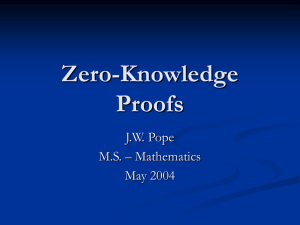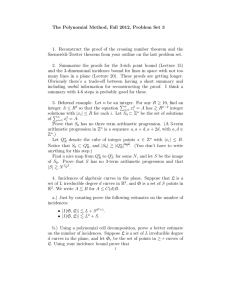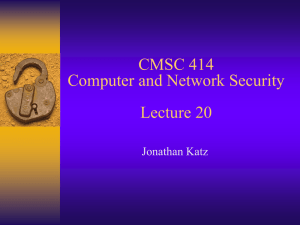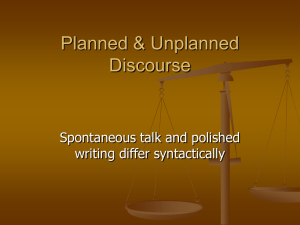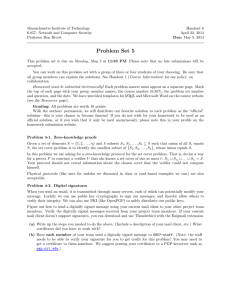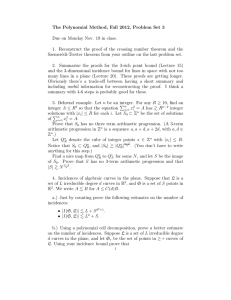The 29th Annual ACM-ICPC World Finals
advertisement
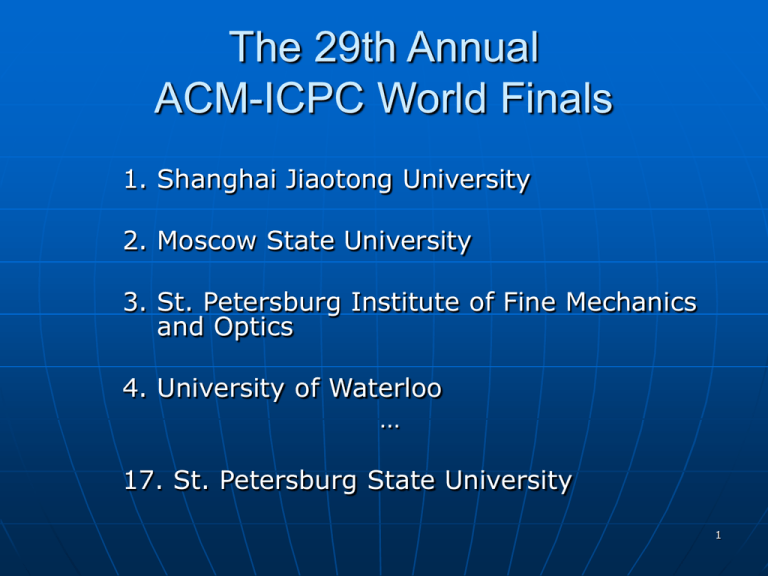
The 29th Annual
ACM-ICPC World Finals
1. Shanghai Jiaotong University
2. Moscow State University
3. St. Petersburg Institute of Fine Mechanics
and Optics
4. University of Waterloo
…
17. St. Petersburg State University
1
Zero Knowledge Proofs and
Protocols
A proof is whatever convinces me.
Shimon Even, 1978
Nikolay Vyahhi
St. Petersburg State University
Joint Advanced Student[s] School 2005
Example (graph 3-coloring)
Problem (G3C): Given a graph, color its vertices with red,
green, blue such that if any two vertices are joined by an
edge then they receive different colors.
(13/14 )
(13/14)10
(13/14)100
(13/14)1000
=
=
=
=
0,929
0,477
6,047*10-4
6,536*10-33
Probability, that A can cheat (when B opened n2 edges) at
most:
(1-1/n)n2 e-n
3
Agenda
Introduction
Theory:
• Interactive Proof Systems, Interactive Protocol
• Zero-Knowledge, QNR example
• Indistinguishability of Random Variables
• Approximability of Random Variables
• Zero-Knowledge
• Known Facts and Open Problems
Examples:
• GI
• GNI
• QNR
Related papers
Exercises
4
Agenda
Introduction
Theory:
• Interactive Proof Systems, Interactive Protocol
• Zero-Knowledge, QNR example
• Indistinguishability of Random Variables
• Approximability of Random Variables
• Zero-Knowledge
• Known Facts and Open Problems
Examples:
• GI
• GNI
• QNR
Related papers
Exercises
5
Introduction
Conception of Zero-Knowledge Proofs
6
Introduction
Applications:
• authentication // user proves to system, that
he is valid user
Weakness: Adversary E can prove to B, that she is A,
just by asking A to prove it to her and simulating this
protocol with B.
• protecting against chosen message attack
by augmenting the ciphertext by a zero-knowledge proof
of knowledge of the cleartext.
• non-oblivious commitment schemes
•…
7
Agenda
Introduction
Theory:
• Interactive Proof Systems, Interactive Protocol
• Zero-Knowledge, QNR example
• Indistinguishability of Random Variables
• Approximability of Random Variables
• Zero-Knowledge
• Known Facts and Open Problems
Examples:
• GI
• GNI
• QNR
Related papers
Exercises
8
Interactive Proof Systems
Intuitively, what should we require from an efficient
theorem-proving procedure?
1. That it should be possible to “prove” a true theorem.
2. That it should be impossible to “prove” a false theorem.
3. That communicating the “proof” should be efficient. Namely
regardless of how much time it takes to come up with the
proof, its correctness should be efficiently verified.
More formal. An interactive Turing machine (ITM) is a
Turing machine equipped with read-only input tape, a work
tape, a random tape, one read-only and one write-only
communication tapes. The random tape contains an
infinite sequence of random bits, and can be scanned only
from left to right.
9
Interactive Proof Systems
Interactive Turing Machine
10
Interactive Protocol
An interactive protocol is an ordered pair of ITM’s A
(prover) and B (verifier) such that A and B share the same
input tape, B’s write-only communication tape is A’s readonly communication tape and vice versa.
Machine A is not computationally bounded, while B is
bounded by a polynomial in the length of common input.
The two machines take turns in being active, with B being
active first. During an active stage A(B) first perform some
internal computation using its tapes; and, second, it writes
a string (for B(A)) on its write-only communication tape.
Then it deactivates and machine B(A) becomes active.
Machine B accepts (or rejects) the input by outputting
“accept” (or “reject”) and terminating the protocol.
11
Interactive Protocol
Interactive Turing Machines
12
Interactive Proof Systems
An interactive protocol (A,B) is called an interactive proof
system for language L over {0,1}* if we have the
following:
1. For each k, for sufficiently large x in L given as input to (A,B),
B halts and accepts with probability at least 1-|x|-k.
2. For each k, for sufficiently large x NOT in L, for any ITM A’, on
input x to (A’,B), B accepts with probability at most |x|-k.
The probabilities here are taken over the readings of
random bits of A and B.
Interactive Polynomial time (IP) is the class of
languages for which there exists interactive proof system.
13
Agenda
Introduction
Theory:
• Interactive Proof Systems, Interactive Protocol
• Zero-Knowledge, QNR example
• Indistinguishability of Random Variables
• Approximability of Random Variables
• Zero-Knowledge
• Known Facts and Open Problems
Examples:
• GI
• GNI
• QNR
Related papers
Exercises
14
Zero-Knowledge
For every polynomial time B’, the
distribution that B’ “sees” on all its
tapes, when interacting with A on
input x∈L, is “indistinguishable” from
a distribution that can be computed
from x in polynomial time.
15
Example (QNR)
Problem (QNR): QNR = { (x,y) | y is quadratic nonresidue mod x }.
There is no such z, that y = z2 mod x.
1.
2.
3.
4.
5.
6.
So let’s try to prove with zero-knowledge for some y, that it is
from QNR. With prover A, verifier B, input (x,y) and |x|=n.
B begins by flipping coins to obtain random bits b1,b2,…,bn.
Then B flips additional coins for obtaining random z1,z2…zn
(0<zi<x and gcd(zi,x)=1 for each zi).
B computes w1,w2,…,wn as follows:
• wi = (zi2) mod x, if bi=0
• wi = (zi2y) mod x, otherwise, if bi=1
B sends w1,w2,…,wn to A.
A computes (somehow) for each i whether or not wi is quadratic
residue mod x, and sends this information (c1,c2,…,cn) to B.
B checks if bi=ci for every i, and if so is “convinced” that
(x,y)∈QNR.
16
Example (QNR)
Is it zero-knowledge?
NO!
Why?
17
Example (QNR)
What if B were to cheat? B could begin by setting
w1=42 for example, and then behave correctly.
So, B can compute whether or not 42 is a
quadratic residue x, given x and a quadratic
nonresidue y. At this time it is not known how
compute this in polynomial time, so this proof
system may not be zero-knowledge!
18
Agenda
Introduction
Theory:
• Interactive Proof Systems, Interactive Protocol
• Zero-Knowledge, QNR example
• Indistinguishability of Random Variables
• Approximability of Random Variables
• Zero-Knowledge
• Known Facts and Open Problems
Examples:
• GI
• GNI
• QNR
Related papers
Exercises
19
Indistinguishability of Random
Variables
Consider families of random variables U = {U(x)}, where
x∈L, a particular subset of {0,1}*, and all random variables
take values in {0,1}*.
Let U(x) and V(x) be two families of random variables.
We want to express the fact that, when the length of x
increases, U(x) essentially becomes “replaceable” by
V(x).
So, a random sample is selected form U(x) or from V(x)
and it is handed to a “judge”. After studying the sample,
he proclaims, from which families our sample is.
20
Indistinguishability of Random
Variables
Two families of random variables {U(x)} and {V(x)} are:
Equal if the judge’s verdict will be meaningless even if he
is given samples of arbitrary size and he can study them for
an arbitrary amount of time.
Statically indistinguishable if the judge’s verdict became
meaningless when he is given an infinite amount of time
but only random, polynomial (in |x|) size samples to work
on.
Computationally indistinguishable if the judge’s verdict
become meaningless when he is only given polynomial
(|x|)-size samples and polynomial (|x|) time.
21
Agenda
Introduction
Theory:
• Interactive Proof Systems, Interactive Protocol
• Zero-Knowledge, QNR example
• Indistinguishability of Random Variables
• Approximability of Random Variables
• Zero-Knowledge
• Known Facts and Open Problems
Examples:
• GI
• GNI
• QNR
Related papers
Exercises
22
Approximability of Random
Variables
Let M be a probabilistic Turing machine that on input x
always halts. We denote by M(x) the random variable that,
for each string, which is equal to α, have the same
probability that M on input x outputs α.
U is perfectly approximable on L if there exist a
probabilistic Turing machine M, running expected
polynomial time, such that for all x∈L, M(x) is equal to U(x).
U is statically (computationally) approximable on L if
there exist a probabilistic Turing machine M, running
expected polynomial time, such that for families of random
variables {M(x)} and {U(x)} are statically
(computationally) indistinguishable on L.
23
Agenda
Introduction
Theory:
• Interactive Proof Systems, Interactive Protocol
• Zero-Knowledge, QNR example
• Indistinguishability of Random Variables
• Approximability of Random Variables
• Zero-Knowledge
• Known Facts and Open Problems
Examples:
• GI
• GNI
• QNR
Related papers
Exercises
24
Zero-Knowledge
ITM B’ has an extra input tape H, which length is bounded
above be a polynomial in the length of x.
When B’ interacts with A, A sees only x on its tape, whereas
B’ sees (x,H).
So H is a some knowledge about x that the cheating B’
already possess. Or H can be considered as the history of
previous interactions that B’ is trying to use to get
knowledge from A.
Let ViewA,B’(x,H) be the random variables whose value is
view of B’ (random tape, messages between parties,
private tape). For convenience, we consider each view to be
a string from {0,1}* of length |x|c for some fixed c>0.
25
Zero-Knowledge
Interactive Turing Machines
26
Zero-Knowledge
Let L be a language and (A,B) a protocol. Let B’ be as
above. We say that (A,B) is perfectly (statically)
(computationally) zero-knowledge on L for B’ if the
family of random variables ViewA,B is perfectly (statically)
(computationally) approximable on
L’ = { (x,H) | x∈L and |H|=|x|c}
We say that interactive protocol (A,B) if perfectly
(statically) (computationally) zero-knowledge on L if
it is perfectly (statically) (computationally) zero-knowledge
on L for all probabilistic polynomial time ITM B’. Note, that
this definition only depends on A and not at all on B.
Usually, only computationally zero-knowledge is consided.
27
Agenda
Introduction
Theory:
• Interactive Proof Systems, Interactive Protocol
• Zero-Knowledge, QNR example
• Indistinguishability of Random Variables
• Approximability of Random Variables
• Zero-Knowledge
• Known Facts and Open Problems
Examples:
• GI
• GNI
• QNR
Related papers
Exercises
28
Known Facts and Open Problems
Every language in NP has a perfect zero knowledge proof
(if one-way permutations exists).
Every language in IP has a zero knowledge proof.
It’s known that (obvious)
BPP PZK SZK CZK IP
Goldreich’s belief is that
BPP PZK SZK CZK = IP
The relationship of PZK and SZK remains an open problem
(with no evidence either way).
29
Agenda
Introduction
Theory:
• Interactive Proof Systems, Interactive Protocol
• Zero-Knowledge, QNR example
• Indistinguishability of Random Variables
• Approximability of Random Variables
• Zero-Knowledge
• Known Facts and Open Problems
Examples:
• GI
• GNI
• QNR
Related papers
Exercises
30
Examples (GI)
Problem (GI – Graph Isomorphism): You have
two graphs (G0,G1), are they isomorphic?
Exercise 0: Think out zero-knowledge proof for
this problem. A knows, that G0 and G1 are
isomorphic (and how its are) and tries to prove
this fact to B.
1.
2.
3.
4.
A chooses one graph (G0 or G1), and transform
it to any another isomorphic one G2 (anyhow).
A sends this graph G2 to B.
B flips a coin, and sends this bit b (0 or 1) to A.
A must show isomorphism of G2 and Gb to B,
otherwise B can not accept.
31
Examples (GI)
If A cheating, she can’t show isomorphism
of those two graphs with probability ½.
But A can cheat with ½ probability also.
If B repeats this protocol n times, so A can
cheat with probability only ½n=2-n (at
most).
B can’t get some additional information
from this interaction.
32
Agenda
Introduction
Theory:
• Interactive Proof Systems, Interactive Protocol
• Zero-Knowledge, QNR example
• Indistinguishability of Random Variables
• Approximability of Random Variables
• Zero-Knowledge
• Known Facts and Open Problems
Examples:
• GI
• GNI
• QNR
Related papers
Exercises
33
Examples (GNI)
Problem (GNI - Graph NonIsomorphism): You have two
graphs (G0,G1), are they nonisomorphic?
1.
2.
3.
B chooses one graph (G0 or G1), and transform it to any
another isomorphic one G2 (anyway).
B sends this graph G2 to A.
A must say, which graph was chosen by B.
If A cheating, so graphs G0 and G1 are isomorphic, and
she can not say exactly, to which one G2 is isomorphic.
Probability of being caught is 1-½n.
B can not get some additional information from this
interaction.
Are you sure in the last point?
34
Examples (GNI)
It is not zero-knowledge!
The same situation as with QNR earlier.
35
Examples (GNI)
Problem (GNI - Graph NonIsomorphism): You have two
graphs (G0,G1), are they nonisomorphic?
We must modify verifier B, so that he’ll prove to the prover
A, that he (B) knows the answer to his query graph (i.e. he
knows an isomorphism to the appropriate input graph), and
the prover answers the query only if she is convinced of
this claim.
Of course, that B’s proof must be zero-knowledge.
36
Agenda
Introduction
Theory:
• Interactive Proof Systems, Interactive Protocol
• Zero-Knowledge, QNR example
• Indistinguishability of Random Variables
• Approximability of Random Variables
• Zero-Knowledge
• Known Facts and Open Problems
Examples:
• GI
• GNI
• QNR
Related papers
Exercises
37
Example (QNR)
Problem (QNR): QNR = { (x,y) | y is quadratic nonresidue
mod x }. There is no such z, that y = z2 mod x.
B picks at random integer r and one bit.
• if bit=0 then B sets w = r2 mod x,
• otherwise w = r2y mod x.
B sends w to A.
For some 1<=j<=m, B picks random integer rj1,rj2 and
random bitj. B sets
• aj=r2j1 mod x
• bj=yr2j2 mod x
If bitj=1, B sends A the ordered pair (aj,bj), else (bj,aj).
A sends B an m-long random bit vector i=i1,i2,…,im.
38
Example (QNR)
B sends A the sequence v=v1,v2,…,vm.
• if ij=0 then vj = (rj1,rj2)
• if ij=1 then
if bit=0 then vj = rrj1 mod x
else vj = yrrj2 mod x.
The intuition behind this step is as follows: if ij=0, then B
is convincing A that pair was chosen correctly; if ij=1 then
B is convincing that if pair was chosen correctly, then w
was chosen correctly.
A verifies that the sequence v was properly constructed, If
not, A sends terminate to B and halts. Otherwise. A sets
answer = 0 if w is a quadratic residue mod x and 1
otherwise, A sends answer to B.
39
Example (QNR)
B checks whether answer = bit. If so B continues the
protocol, otherwise B rejects and halts.
After m repetition of this protocol, if B did not reject thus
far, B accepts and halts.
Conclusion: So, we force B to prove, that he is not cheating.
And now he can not obtain any other information from this
protocol (only is y a quadratic nonredisue or not). => It’s a
(statically) zero-knowledge proof.
40
Non-Interactive ZK Proofs
General Idea: Using one-way function instead of verifier B.
A generates n random numbers, and so generates n
different isomorphic (to initial) problems.
A publish all this new problems.
A uses one-way functions, to generate “random” bit string
b from definitions of that new problems, which was
published (it’ll be like B’s random tape).
If bi=0 then A proves isomorphism of initial and i-th new
problem, otherwise she opens solution of i-th new
problem. Then A publish this information.
Anyone can verify this proof without interaction.
41
Agenda
Introduction
Theory:
• Interactive Proof Systems, Interactive Protocol
• Zero-Knowledge, QNR example
• Indistinguishability of Random Variables
• Approximability of Random Variables
• Zero-Knowledge
• Known Facts and Open Problems
Examples:
• GI
• GNI
• QNR
Related papers
Exercises
42
Related papers
S. Goldwasser, S. Micali, C. Rackoff. “The knowledge
complexity of interactive proof systems”, 1989 (1986).
U. Fiege, A. Fiat, A. Shamir. “Zero-Knowledge Proofs of
Identity”, 1988.
B. Schneier. “Applied Cryptography”, 1996.
O. Goldreich. “Foundation of Cryptography”, 2001.
43
Thank you!
44
Questions?
45
Agenda
Introduction
Theory:
• Interactive Proof Systems, Interactive Protocol
• Zero-Knowledge, QNR example
• Indistinguishability of Random Variables
• Approximability of Random Variables
• Zero-Knowledge
• Known Facts and Open Problems
Examples:
• GI
• GNI
• QNR
Related papers
Exercises
46
Exercises
ZK proof for G3C by using a
phone/email (you can’t see, what
your opponent do, so you can’t
believe in something sometimes).
47
Agenda
Introduction
Theory:
• Interactive Proof Systems, Interactive Protocol
• Zero-Knowledge, QNR example
• Indistinguishability of Random Variables
• Approximability of Random Variables
• Zero-Knowledge
• Known Facts and Open Problems
Examples:
• GI
• GNI
• QNR
Related papers
Exercises
48
Thank you again!
49
